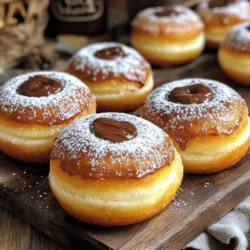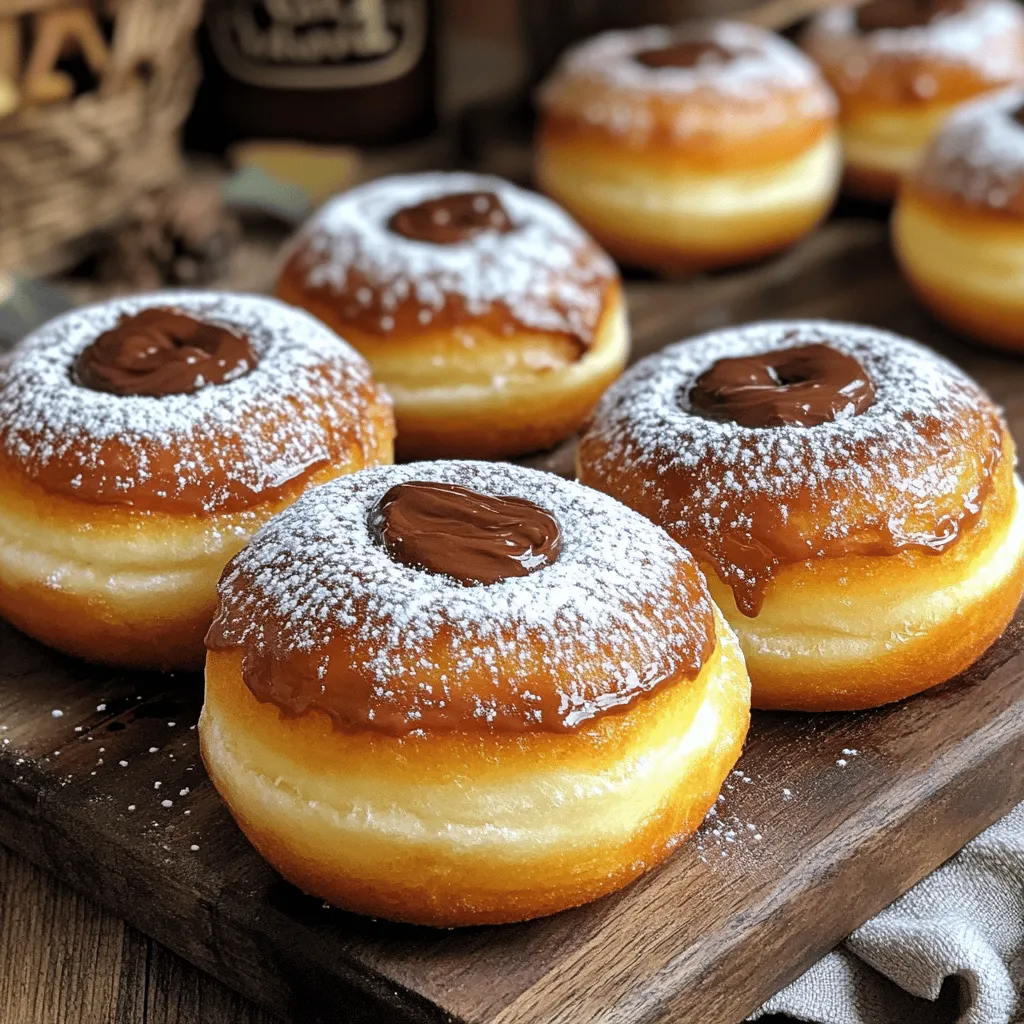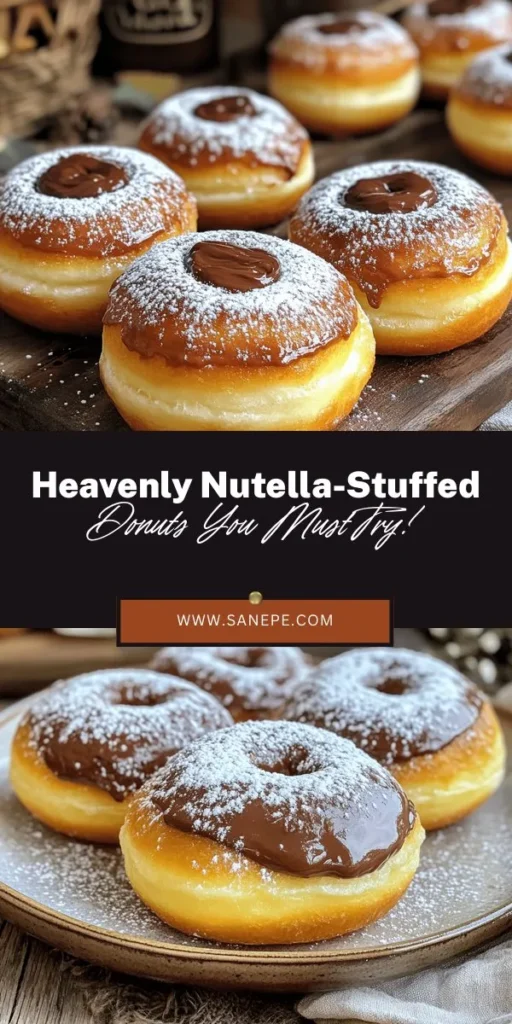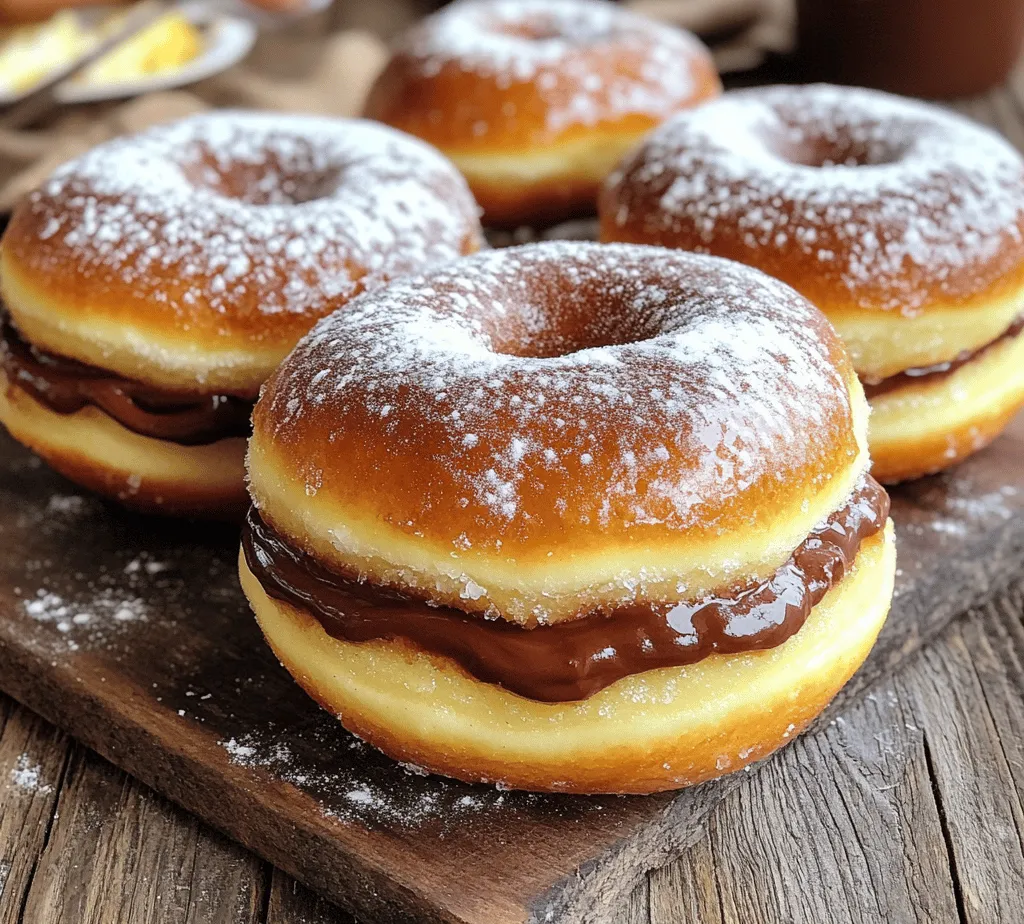Introduction
Indulge your senses and elevate your baking game with the delightful recipe for Nutella Stuffed Donuts. These delectable treats combine the soft, fluffy texture of freshly made donuts with the rich, creamy goodness of Nutella, creating a sweet experience that is hard to resist. Whether you’re planning a special breakfast for your loved ones, celebrating a special occasion, or simply craving something sweet to brighten your day, Nutella Stuffed Donuts are the perfect solution.
In this article, we will guide you through each step of the process to create these mouthwatering donuts at home. From understanding the essential ingredients to providing detailed instructions for making the perfect dough, shaping the donuts, and ensuring they rise beautifully, we aim to equip you with the knowledge and confidence to make these delicious pastries. So, let’s dive into this sweet adventure!
Understanding the Ingredients
To create Nutella Stuffed Donuts that are not just enjoyable but also have the perfect texture and flavor, it’s essential to understand the role of each ingredient. Here’s a closer look at the core components that come together to make these donuts irresistible:
All-Purpose Flour
All-purpose flour serves as the foundation of our donuts. It provides structure and texture, ensuring that your donuts are soft yet sturdy enough to hold their shape. The quality of the flour can significantly impact the final product, so opt for a high-quality brand for the best results.
Granulated Sugar
Granulated sugar adds sweetness to the dough and contributes to the browning process during frying. This not only enhances the flavor but also gives the donuts a beautiful golden hue. The amount of sugar can be adjusted based on your preference for sweetness.
Instant Yeast
Instant yeast is a crucial ingredient that ensures the donuts rise and become fluffy. Unlike traditional yeast, instant yeast does not require proofing; it can be mixed directly with the dry ingredients, making the preparation process quicker and more convenient.
Salt and Ground Nutmeg
Salt is essential for balancing the sweetness of the donuts, while ground nutmeg adds a warm, aromatic flavor that elevates the overall taste. These ingredients work together to create a more complex flavor profile that complements the Nutella filling.
Whole Milk
Whole milk contributes moisture and richness to the dough, making it tender and delightful. The fat content in whole milk plays a crucial role in the texture of the donuts, ensuring they are soft and luscious.
Unsalted Butter
Unsalted butter is another key ingredient that adds flavor and tenderness. It enriches the dough, providing a delicious buttery taste that pairs perfectly with the sweetness of the sugar and the creaminess of the Nutella.
Eggs
Eggs serve multiple purposes in this recipe. They enrich the dough, adding moisture and fat, while also helping to bind the ingredients together. This results in a more cohesive dough that can be shaped easily.
Vanilla Extract
A splash of vanilla extract infuses the donuts with a warm, inviting aroma. It enhances the overall flavor, making each bite a delightful experience.
Nutella
The star of the show, Nutella, provides a luscious filling that transforms a simple donut into a decadent treat. Its rich, chocolate-hazelnut flavor melts in your mouth, making it a favorite among both children and adults.
Vegetable Oil
Vegetable oil is necessary for frying the donuts, allowing them to achieve a crispy exterior while remaining soft and fluffy inside. The right oil can also contribute to the overall flavor, so choose one that has a neutral taste.
Powdered Sugar
Finally, a dusting of powdered sugar adds the finishing touch to your Nutella Stuffed Donuts. Not only does it enhance the visual appeal, but it also adds a hint of sweetness that perfectly complements the rich filling.
Step-by-Step Guide to Making Nutella Stuffed Donuts
Crafting the Perfect Dough
Preparing the Dough
To begin your Nutella Stuffed Donuts adventure, gather all your ingredients and start by mixing the dry components. In a large mixing bowl, combine the all-purpose flour, granulated sugar, instant yeast, salt, and ground nutmeg. This step ensures that the yeast is evenly distributed throughout the flour, which is critical for even rising.
Next, in a separate bowl, whisk together the wet ingredients: warm whole milk, melted unsalted butter, eggs, and vanilla extract. Ensure the milk is warm but not hot, as excessive heat can kill the yeast. Once mixed, pour the wet ingredients into the dry mixture, stirring until a cohesive dough forms.
Kneading Techniques
Kneading is an essential step in developing the gluten structure of the dough, which contributes to its elasticity and chewiness. Lightly flour a clean surface and turn the dough out onto it. Knead the dough for about 8-10 minutes, or until it becomes smooth and elastic. You can use the “push, fold, turn” technique: push the dough away with the heel of your hand, fold it back over itself, and turn it a quarter turn.
If the dough is too sticky, sprinkle a little more flour as needed, but be careful not to add too much, which can make the donuts dense. Your goal is to achieve a soft, pliable dough that springs back when poked.
Proving the Dough
After kneading, place the dough in a lightly greased bowl and cover it with a clean kitchen towel or plastic wrap. This will create a warm environment for the dough to rise. Let it prove in a draft-free area for about 1-2 hours, or until it has doubled in size. The timing may vary based on the temperature and humidity of your kitchen, so keep an eye on it.
For optimal rising conditions, you can preheat your oven to the lowest setting for a few minutes and then turn it off. Place the bowl inside the warm oven to encourage the dough to rise more quickly.
Shaping the Donuts
Techniques for Cutting Donuts
Once the dough has risen, it’s time to shape the donuts. Gently punch down the dough to release any trapped air and turn it out onto a floured surface. Roll the dough out to about 1/2 inch thickness.
Using a donut cutter or two round cutters (one larger for the outside and a smaller one for the hole), cut out the donuts. If you don’t have a donut cutter, you can use a glass for the outer circle and a bottle cap for the hole.
Importance of Second Rise
After cutting the donuts, it’s crucial to allow them to rise again. Place the cut donuts on parchment paper or a floured baking sheet, ensuring they are spaced apart to avoid sticking. Cover them with a kitchen towel and let them rise for another 30-45 minutes. This second rise is key to achieving the fluffy texture that makes these donuts so delightful.
As the donuts rise, you can prepare your frying setup. Fill a deep pot or fryer with vegetable oil, ensuring it reaches about 2-3 inches deep. Heat the oil to 350°F (175°C) — the perfect temperature for frying donuts.
With the dough prepared and the oil ready, you’re well on your way to enjoying the most delightful Nutella Stuffed Donuts. Stay tuned for the next part, where we will dive into the frying process, filling the donuts with Nutella, and finishing touches that will take your homemade treats to the next level.
Frying the Donuts
Choosing the Right Oil
When it comes to frying donuts, the choice of oil is crucial to achieving the perfect texture and flavor. The best oils for frying are those with a high smoke point, which prevents the oil from burning and developing an unpleasant taste. Some popular options include vegetable oil, canola oil, and peanut oil. These oils not only withstand high temperatures but also impart a neutral flavor that allows the sweetness of the donuts to shine.
Avoid using olive oil for frying donuts, as it has a lower smoke point and a distinct flavor that may not complement the sweetness of your treat. Additionally, using oil that is too old can affect the taste of your donuts, so always opt for fresh oil for the best results.
Monitoring Temperature
Maintaining the right oil temperature is key to frying donuts successfully. The ideal frying temperature is between 350°F to 375°F (175°C to 190°C). If the oil is too hot, the donuts will brown too quickly on the outside while remaining raw on the inside. Conversely, if the oil is not hot enough, the donuts will absorb too much oil, resulting in a greasy texture.
To monitor the oil temperature accurately, use a deep-fry thermometer. If you don’t have one, you can test the oil’s readiness by dropping a small piece of dough into the oil. If it sizzles and rises to the surface, the oil is hot enough. Frying in small batches is also advisable; this helps to maintain the oil temperature and ensures even cooking.
Frying Tips
When it comes to frying your donuts, less is more. Overcrowding the pan can lead to a drop in oil temperature, resulting in donuts that are soggy and unevenly cooked. Fry your donuts in batches, allowing enough space between each piece for them to float and move freely.
Carefully place the donuts into the hot oil using a slotted spoon or spider strainer. Fry for about 2-3 minutes on each side or until they are golden brown. Once cooked, remove the donuts from the oil and drain them on a plate lined with paper towels to absorb excess oil. This step is essential for ensuring a light, airy texture.
Filling and Serving the Donuts
Filling Techniques
Filling your donuts with Nutella is one of the most exciting parts of the process. To achieve a perfect filling, you can use a piping bag fitted with a round tip. After frying and cooling the donuts slightly, insert the piping tip into the side of each donut and gently squeeze the Nutella inside. Aim for a nice, generous portion but avoid overfilling, as this can cause the donuts to burst.
If you don’t have a piping bag, you can use a plastic sandwich bag with one corner snipped off. This makeshift option works just as well! Alternatively, you can use a small squeeze bottle for more precision. Whichever method you choose, ensure that the filling is warm and pliable for easier piping.
Dusting with Powdered Sugar
For that finishing touch, dust your filled donuts with powdered sugar. This not only enhances the visual appeal but also adds a touch of sweetness. To dust the donuts, place powdered sugar in a fine-mesh sieve and gently tap it over the donuts. This method ensures an even coating without clumps. For an extra flair, consider adding a pinch of cinnamon to the powdered sugar for a delightful flavor contrast.
Serving Suggestions
Nutella stuffed donuts are best served warm and fresh. You can present them on a beautiful platter and pair them with a side of fresh berries or a scoop of vanilla ice cream for an indulgent dessert. For a breakfast twist, serve them alongside a hot cup of coffee or a glass of cold milk. These donuts also make a delightful treat for gatherings and celebrations, impressing your guests with their delicious filling and light, fluffy texture.
Flavor Variations and Customizing Your Donuts
Exploring Different Stuffing Options
While Nutella is a fantastic choice, there are numerous alternative fillings that can elevate your donut game. Consider using fruit preserves, such as raspberry or strawberry, for a fruity twist. Lemon curd or pastry cream can also offer a refreshing contrast to the fried dough. If you’re feeling adventurous, try filling your donuts with flavored creams like coconut or coffee.
Another fun option is to create a layered filling by combining Nutella with a fruit preserve for a delightful mix of flavors. The possibilities are endless, and experimenting with different fillings can lead to exciting new creations.
Flavoring the Dough
To enhance the flavor of your donuts, consider adding spices or citrus zest to the dough. A teaspoon of cinnamon, nutmeg, or even cardamom can add warmth and depth to your donuts. Additionally, incorporating lemon or orange zest can brighten the flavor profile, making your donuts even more enticing. Just remember to balance these additions carefully so they complement the sweetness of the Nutella.
Topping Ideas
Creative Toppings
Donuts can be made even more enticing with a variety of toppings. After dusting with powdered sugar, consider drizzling your donuts with a rich chocolate glaze or a simple icing made from powdered sugar and milk. Sprinkles, crushed nuts, or even toasted coconut can add texture and additional flavor to your creations.
For a more gourmet approach, consider topping your Nutella stuffed donuts with a dollop of whipped cream or a scoop of ice cream, transforming them into a decadent dessert worthy of any occasion.
Pairing Suggestions
To complement your delicious Nutella stuffed donuts, serve them with beverages that enhance the overall experience. A strong cup of coffee or espresso pairs beautifully with the sweetness of the donuts, while a glass of cold milk provides a refreshing counterpoint. For a more indulgent treat, consider serving your donuts alongside a rich hot chocolate or a flavored latte, making for a perfect breakfast or dessert.
The Science Behind Donut Making
Understanding Yeast and Fermentation
The heart of any good donut lies in the dough, which is typically yeast-based. Yeast is a living organism that ferments sugars in the dough, producing carbon dioxide gas. This gas causes the dough to rise, giving the donuts their light and airy texture. Understanding the role of yeast is essential for successful donut making.
The fermentation process can be influenced by temperature; warmer environments encourage yeast activity, speeding up the rise. As a general rule, dough should be allowed to rise in a warm area, away from drafts. A good tip is to place the dough in an oven that is turned off but has the light on, creating a cozy environment for the yeast to thrive.
Texture and Cooking Techniques
Achieving the perfect crust on your donuts is a balancing act between cooking time and temperature. When frying, the hot oil creates a crispy exterior that seals in moisture. This results in donuts that are both crunchier on the outside and softer on the inside.
The timing of the frying process is crucial; too little time will yield undercooked donuts, while too much can lead to a dry, overcooked product. Additionally, balancing sweetness is important. The sugar in the dough caramelizes during frying, contributing to the flavor and color of your donuts. The combination of flavors and textures is what makes your Nutella stuffed donuts an irresistible treat.
Conclusion
Nutella stuffed donuts are more than just a sweet treat; they are a delightful experience that can elevate any occasion. By mastering the art of donut making, you not only create a delicious dessert but also gain a deeper understanding of baking fundamentals. Whether you enjoy them fresh out of the fryer or experiment with variations, these donuts are sure to please everyone. Embrace your baking journey, and enjoy every bite of your homemade Nutella stuffed delights. With a little practice and creativity, you can turn this indulgent dessert into a family favorite that will bring smiles to faces and joy to any gathering.



